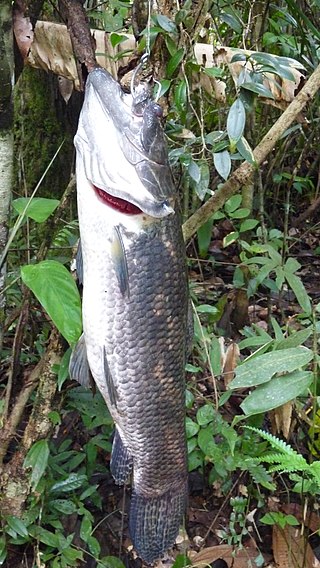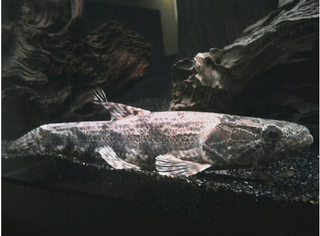
Characiformes is an order of ray-finned fish, comprising the characins and their allies. Grouped in 18 recognized families, more than 2000 different species are described, including the well-known piranha and tetras.

Characidae, the characids or characins, is a family of freshwater subtropical and tropical fish belonging to the order Characiformes. The name "characins" is an historical one, but scientists today tend to prefer "characids" to reflect their status as a, by and large, monophyletic group. To arrive there, this family has undergone much systematic and taxonomic change. Among those fishes remaining in the Characidae currently are the tetras, comprising the very similar genera Hemigrammus and Hyphessobrycon, as well as a few related forms, such as the cave and neon tetras. Fish of this family are important as food in several regions, and also constitute a large percentage of captive freshwater aquarium fish species.

Hoplias aimara, also known as anjumara, traíra, trahira, manjuma, anjoemara and wolf fish, is a species of freshwater fish found in the rivers of South America. In Amazonia, the native populations are concerned by high levels of mercury contamination which have been linked to the consumption of contaminated fish. H. aimara is a good bioindicator of such contamination.

Hoplias is a genus of fish in the family Erythrinidae found in Central and South America.

Hoplias malabaricus, also known as the wolf fish, tiger fish, guabine or trahira, is a predatory Central and South American freshwater ray-finned fish of the characiform family Erythrinidae.

Hoplias curupira, also known as the black wolf-fish, has a wide distribution in the Amazon basin but was described as recently as 2009.

Hoplias australis is a predatory freshwater characin fish of the southern Neotropics.
Hoplias brasiliensis is a species of trahiras. It is a benthopelagic, tropical freshwater fish which is known from coastal rivers in northeastern Brazil, including the Paraguaçu River in Bahia, the Pardo River, the Jequitinhonha River in Minas Gerais and Espírito Santo, and the Contas River. Male H. brasiliensis can reach a maximum length of 20.3 centimetres.
Hoplias lacerdae is a predatory freshwater characin fish from South America. They are commonly known are trairão in Brazilian Portuguese.
Hoplias microcephalus is a species of trahiras. It is a tropical, benthopelagic freshwater fish which is known to inhabit the São Francisco River in Brazil. Males can reach a maximum length of 35.6 centimetres.

Hoplias microlepis is a species of trahira found in Central and South America.
Hoplias patana is a species of trahiras. It is a freshwater fish which is known from Cayenne, French Guiana. The maximum length recorded for this species is 39.4 centimetres.
Hoplias teres is a species of trahiras. It is a tropical, benthopelagic freshwater fish which is known to inhabit Lake Maracaibo in Venezuela. Males can reach a maximum length of 15.3 centimetres.

Erythrinus erythrinus, the red wolf fish, is a relatively small species of trahira from freshwater habitats in South America.

Ectrepopterus uruguayensis is a small species of characin originally recorded only from streams in Uruguay, with occasional sightings in Brazil and Argentina. It is the only known member of the genus Ectrepopterus, which was formerly a subgenus of Megalamphodus. Given its restricted range, it is considered a rare fish, and is of note for conservation researchers interested in preserving the biodiversity of the region.
Apareiodon affinis, the darter characine, is a species of fresh water ray-finned fish native to the Río de la Plata Basin in southern Brazil, Paraguay and northern Argentina.
Hoplerythrinus gronovii is a species of trahira. It is a tropical, pelagic freshwater fish.

Astyanax altiparanae, sometimes called the yellow-tail tetra or yellow-tail lambari, is a species of schooling freshwater fish widely distributed across the southern half of South America. It is an ecologically flexible species, able to adapt to various resource and space conditions, and its diet follows this pattern; it is considered opportunistic and omnivorous. Its widespread nature and unspecified ecology contribute to its status as a species of least concern on the IUCN Red List. It was originally described from the upper Paraná river basin, which is the origin of its specific epithet; "alto" means "higher" in Brazilian Portuguese, hence "alto Paraná".

Astyanax clavitaeniatus is a small species of freshwater fish native to various rivers in the Amazon basin. It is characterized by a club-shaped lateral stripe, which is where it gets its scientific name; "clava" means "club", and "taenia" means "stripe". It is a deep-bodied fish with a silvery base color, which is not uncommon for members of Astyanax. Its markings - including a humeral spot and two vertical brown bars - indicate that it is a part of a species complex centered around congener Astyanax bimaculatus.
Paleohoplias is an extinct monospecific genus of fish in the family Erythrinidae found in Brazil, South America. The type species Paleohoplias assisbrasiliensis was described in 2003, and was found in Solimões Formation in the State of Acre, Brazil, dating to Huayqueriense-Montehermoseuse age.












